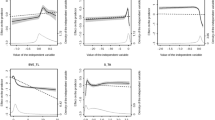Abstract
We assess whether two popular accounting-based measures, Altman’s (1968) Z-Score and Ohlson’s (1980) O-Score, effectively summarize publicly-available information about the probability of bankruptcy. We compare the relative information content of these Scores to a market-based measure of the probability of bankruptcy that we develop based on the Black–Scholes–Merton option-pricing model, BSM-Prob. Our tests show that BSM-Prob provides significantly more information than either of the two accounting-based measures. This finding is robust to various modifications of Z-Score and O-Score, including updating the coefficients, making industry adjustments, and decomposing them into their lagged levels and changes. We recommend that researchers use BSM-Prob instead of Z-Score and O-Score in their studies and provide the SAS code to calculate BSM-Prob.
Similar content being viewed by others
References
Altman, E. (1968). “Financial Ratios, Discriminant Analysis and the Prediction of Corporate Bankruptcy.” Journal of Finance 23, 589–609.
Barth, M., W. Beaver and W. Landsman. (1998). “Relative Valuation Roles of Equity Book Value and Net Income as a Function of Financial Health.” Journal of Accounting and Economics 25, 1–34.
Beaver, W. (1966). “Financial Ratios as Predictors of Bankruptcy.” Journal of Accounting Research 6, 71–102.
Beaver, W. (1968). “Market Prices, Financial Ratios, and the Prediction of Failure.” Journal of Accounting Research 8, 179–192.
Beck, N., J. Katz and R. Tucker. (1998). “Taking Time Seriously: Time-Series-Cross-Section Analysis with a Binary Dependent Variable.” American Journal of Political Science 42, 1260–1288.
Begley, J., J. Ming and S. Watts. (1996). “Bankruptcy Classification Errors in the 1980's: An Empirical Analysis of Altman's and Ohlson's Models.” Review of Accounting Studies 1, 267–284.
Berger, P., E. Ofek and I. Swary. (1996). “Investor Valuation of the Abandonment Option.” Journal of Financial Economics 42, 257–287.
Billings, B. (1999). “Revisiting the Relation between the Default Risk of Debt and the Earnings Response Coefficient.” Accounting Review 74:4, 509–522.
Black, F. and J. Cox. (1976). “Valuing Corporate Securities: Some Effects of Bond Indenture Provisions.” Journal of Finance 31:2, 351–367.
Black, F. and M. Scholes. (1973). “The Pricing of Options and Corporate Liabilities.” Journal of Political Economy 7, 637–654.
Burgstahler, D., J. Jiambalvo and E. Noreen. (1989). “Changes in the Probability of Bankruptcy and Equity Value.” Journal of Accounting and Economics 11, 207–224.
Campbell, J., M. Lettau, B. Malkiel and Y. Xu. (2001). “Have Individual Stocks Become More Volatile? An Empirical Exploration of Idiosyncratic Risk.” Journal of Finance 56:1, 1–43.
Cheung, J. (1991). “A Review of Option-Pricing Theory in Accounting Research.” Journal of Accounting Literature 10, 51–84.
Core, J. and C. Schrand. (1999). “The Effect of Accounting-Based Debt Covenants on Equity Valuation.” Journal of Accounting and Economics 27:1, 1–34.
Dambolena, I. and S. Khoury. (1980). “Ratio Stability and Corporate Failure.” Journal of Finance 35:4, 1017–1026.
Delaney, K. (1992). Strategic Bankruptcy. Berkeley, CA: University of California Press.
Dhaliwal, D., K. Lee and N. Fargher. (1992). “The Association between Unexpected Earnings and Abnormal Security Returns in the Presence of Financial Leverage.” Contemporary Accounting Research 8, 20–41.
Dhaliwal, D. and S. Reynolds. (1994). “The Effect of the Default Risk of Debt on the Earnings Response Coefficient.” Accounting Review 69:2, 412–419.
Dichev, I. (1998). “Is the Risk of Bankruptcy a Systematic Risk?” Journal of Finance 53:3, 1131–1147.
Fama, E. and K. French. (1997). “Industry Costs of Equity.” Journal of Financial Economics 43:2, 153–193.
Francis, J. (1990). “Corporate Compliance with Debt Covenants.” Journal of Accounting Research 28, 326–347.
Geske, R. (1977). “The Valuation of Corporate Liabilities as Compound Options.” Journal of Financial and Quantitative Analysis 12:4, 541–552.
Griffin, J. and M. Lemmon. (2002). “Book-to-Market Equity, Distress Risk, and Stock Returns.” Journal of Finance 57:5, 2317–2336.
Han, B., R. Jennings and J. Noel. (1992). “Communication of Nonearnings Information at the Financial Statements Release Date.” Journal of Accounting and Economics 15:1, 63–86.
Lo, A. (1986). “Logit versus Discriminant Analysis: A Specification Test and Application to Corporate Bankruptcies.” Journal of Econometrics 31, 151–178.
Lys, T. (1984). “Mandated Accounting Changes and Debt Covenants: The Case of Oil and Gas Accounting.” Journal of Accounting and Economics 7, 39–65.
McDonald, R. (2002). Derivative Markets. Boston, MA: Addison Wesley.
McFadden, D. (1976). “A Comment on Discriminant Analysis versus Logit Analysis.” Annals of Economic and Social Measurement 5, 511–523.
Merton, R. (1974). “On the Pricing of Corporate Debt: The Risk Structure of Interest Rates.” Journal of Finance 29, 449–470.
Ohlson, J. (1980). “Financial Ratios and the Probabilistic Prediction of Bankruptcy.” Journal of Accounting Research 19, 109–131.
Opler, T. and S. Titman. (1994). “Financial Distress and Corporate Performance.” Journal of Finance 49:3, 1015–1040.
Palepu, K. (1986). “Predicting Takeover Targets: A Methodological and Empirical Analysis.” Journal of Accounting and Economics 8, 3–35.
Platt, H. and M. Platt. (1991). “A Note on the Use of Industry-Relative Ratios in Bankruptcy Prediction.” Journal of Banking and Finance 15, 1183–1194.
Rogers, W. (1993). “Regression Standard Errors in Clustered Samples.” Stata Technical Bulletin 13, 88–94.
Sharpe, W. (1982). “Factors in New York Stock Exchange Security Returns.” Journal of Portfolio Management 8:4, 5–19.
Shumway, T. (2001). “Forecasting Bankruptcy More Accurately: A Simple Hazard Model.” Journal of Business 74:1, 101–124.
Sloan, R. (1996). “Do Stock Prices Fully Reflect Information in Accruals and Cash Flows About Future Earnings?” Accounting Review 71:3, 289–315.
Stone, M. (1991). “Firm Financial Stress and Pension Plan Continuation/Replacement Decisions.” Journal of Accounting and Public Policy 10, 175–206.
Subramanyam, K. and J. Wild. (1996). “The Going Concern Assumption and the Informativeness of Earnings.” Contemporary Accounting Research 13, 251–274.
Vassalou, M. and Y. Xing. (2004). “Default Risk in Equity Returns.” Journal of Finance 59:2, April 2004.
Vuong, Q. (1989). “Likelihood Ratio Tests for Model Selection and Non-Nested Hypotheses.” Econometrica 57:2, 307–333.
Warren, S. (2003). “Asbestos Quagmire.” Wall Street Journal Jan. 27, B1.
Zmijewski, M. (1984). “Methodological Issues Related to the Estimation of Financial Distress Prediction Models.” Journal of Accounting Research Supplement, 59–86.
Author information
Authors and Affiliations
Corresponding author
Rights and permissions
About this article
Cite this article
Hillegeist, S.A., Keating, E.K., Cram, D.P. et al. Assessing the Probability of Bankruptcy. Review of Accounting Studies 9, 5–34 (2004). https://doi.org/10.1023/B:RAST.0000013627.90884.b7
Issue Date:
DOI: https://doi.org/10.1023/B:RAST.0000013627.90884.b7




